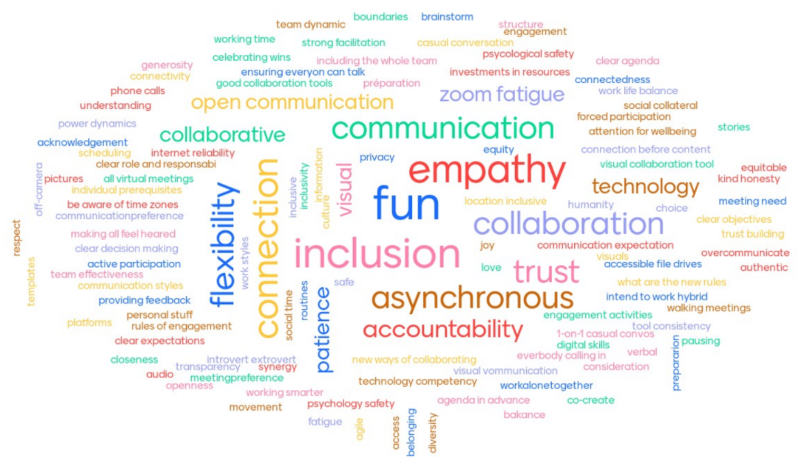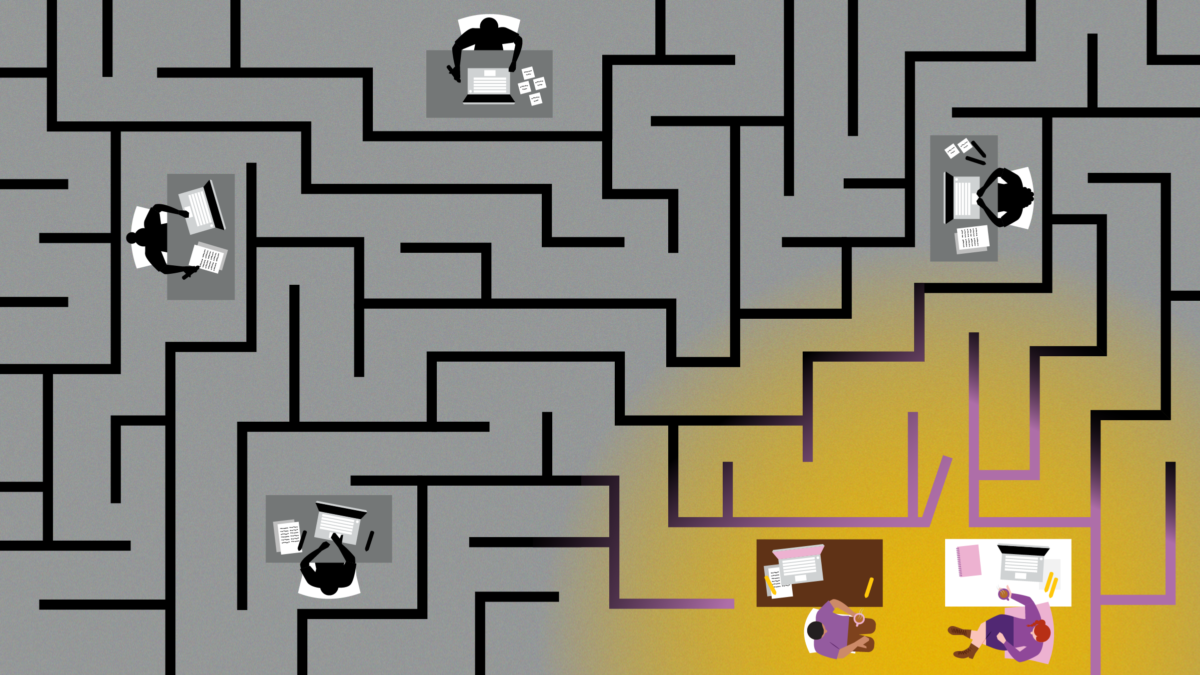This blog post is a summary of our webinar Leadership Tools and Techniques for Navigating the Hybrid Workplace. We invite you to view the recording for expanded content, including learnings from experts at XPLANE and MURAL.
As hybrid teams become the new normal, what’s the secret (or key) to nurturing robust communication and collaboration between people in the office and those working remotely? Adopting a digital-first mindset. Here’s how to get started.
For many of us, the hybrid workplace—an environment in which some colleagues work in a central office and others work remotely—is not new.
We also know it’s here to stay.
Recent studies indicate 73% of workers want flexible remote work options and 66% of companies are considering office redesigns to support a hybrid model.
As hybridity proliferates, how are the needs of teams changing and how can we adapt our ways of working to successfully communicate, collaborate, and include everyone—no matter where they work from?
The Unique Needs of Hybrid Teams
When we asked webinar participants what hybrid teams need to thrive, several themes arose:

One overarching theme was inclusivity.
According to the Society for Human Resource Management (SHRM), inclusivity is “a work environment in which all individuals are treated fairly and respectfully, have equal access to opportunities and resources, and can contribute fully to the organization’s success.”
Given this, we need to shift our mindset and approach work with a location-agnostic lens—and the key to making this happen is to adopt a “digital-first” mindset.
Why “Digital-First” Matters
Back in the day (pre-COVID), if you were the one remote person trying to join a meeting with co-workers at the office, it was probably not a very inclusive experience for you.
Perhaps your coworkers in the office forgot to connect you by phone or video. Even if they remembered you, it was probably difficult to follow what they were saying and looking at.
Adopting a digital-first mindset means we inherently create an inclusive environment. Team collaboration is instantly achieved, and all workers have equal access to information—no matter location or time.
Balancing Synchronous and Asynchronous Communication
A digital-first mindset requires us to find a new balance between synchronous and asynchronous communication and collaboration.
Synchronous communication, like in-person meetings and video conferences, happens in real time, whereas asynchronous communication can be accessed and responded to at any time.
Asynchronous modes of communication and collaboration consider team members unable to join all synchronous meetings due to location or time zone.
This is important because when relevant information is digitized and available anytime, we create a more inclusive environment.
Co-Create Your Hybrid Team Model
Adapting to the needs of a hybrid team is a continual process; there’s no “one size fits all” approach.
Involve your team in brainstorming ideas and making agreements about how to create an inclusive environment for all. At XPLANE, we like to use our Ways of Working worksheet to facilitate discussions such as this.
Note: To get the most from this worksheet, we recommend you view this video tutorial.
- Do all your regular meetings need to take place in real time?
- Could meetings be shorter? (Example: Could you post a PPT presentation for the team to review before the meeting and thus use meeting time to focus on discussions, decision-making, and Q&A?)
- What other synchronous rituals exist that are hindering development of an inclusive environment?
Tools That Support a Digital-First Environment

A virtual collaboration tool, MURAL is a digital workspace that allows large groups of people to be active in the same place at the same time (think virtual sticky-note brainstorm session).
Because everything is digitally native, meaning accessible by digital means, MURAL enables easy asynchronous communication and collaboration.

Loom is a screen and video recording tool that makes it easy to add your face and voice to messages, like bringing an otherwise static email to life.
Because it enables clarity of intention and tone that can otherwise get lost in written messages, Loom is great for asynchronous communication.
An added bonus: People remember more information via video than text, giving Loom videos extra staying power.

A fun live polling tool, Mentimeter helps foster a healthy hybrid team culture by providing an easy way to gather quick and anonymous feedback, create word clouds in real time together, and much more.
Mentimeter is a great digital-first tool because it enables balanced participation where everyone can equally contribute ideas and engage, regardless of location.
A Winning Combination
As you work with hybrid teams, remember a digital-first mindset encompasses more than just cool tools and platforms. First and foremost, it’s about inclusivity.
Together, an inclusive mindset and flexible digital tools will go far toward keeping your teams engaged, involved, and working across the hybrid landscape with ease.
Additional Tools and Resources
To learn more about nurturing inclusivity in hybrid teams, we recommend the following tools and resources:
- The Right Tool for the Job: Three Simple Steps to Better Communications (learn how to map communications needs and types to appropriate channels with our communication spectrum activity)
- Future of Work: Grow a Thriving Workplace, Virtually (webinar recording)
- How to Foster Trust on Remote Teams
- How to Plan a Thriving Future Workplace
- Future Work Environment Planner Worksheets (a tool that helps individuals or teams develop their ideal hybrid workspace)
And as always, feel free to reach out to us with questions or comments on this post or webinar.

How To Create a Kinder, More Inclusive Work Environment
In any organization, cultivating high-quality interactions can improve productivity, speed, and innovation.1 Here’s a handful of ways to work toward a healthy, inclusive workplace full

Culture and Collaboration in the Post-COVID Workplace
This interview was conducted by Chuck Frey and was originally published in the NEXT/EDGE newsletter. Cultivate these skills to contribute more value in remote and

Tips and Tools for Great Hybrid Workplace Communication and Collaboration
As hybrid teams become the new normal, what’s the secret (or key) to nurturing robust communication and collaboration between people in the office and those working remotely? Adopting a digital-first mindset. Here’s how to get started.